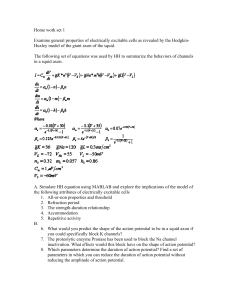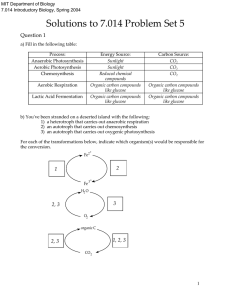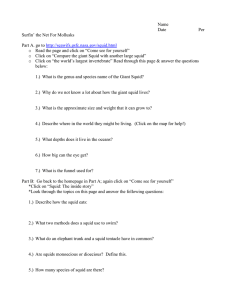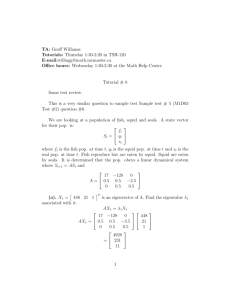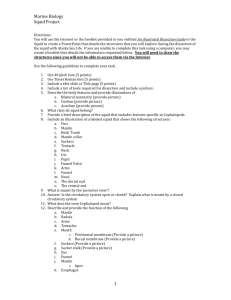MIT Department of Biology 7.014 Introductory Biology, Spring 2004 Name:__________________________________________
advertisement
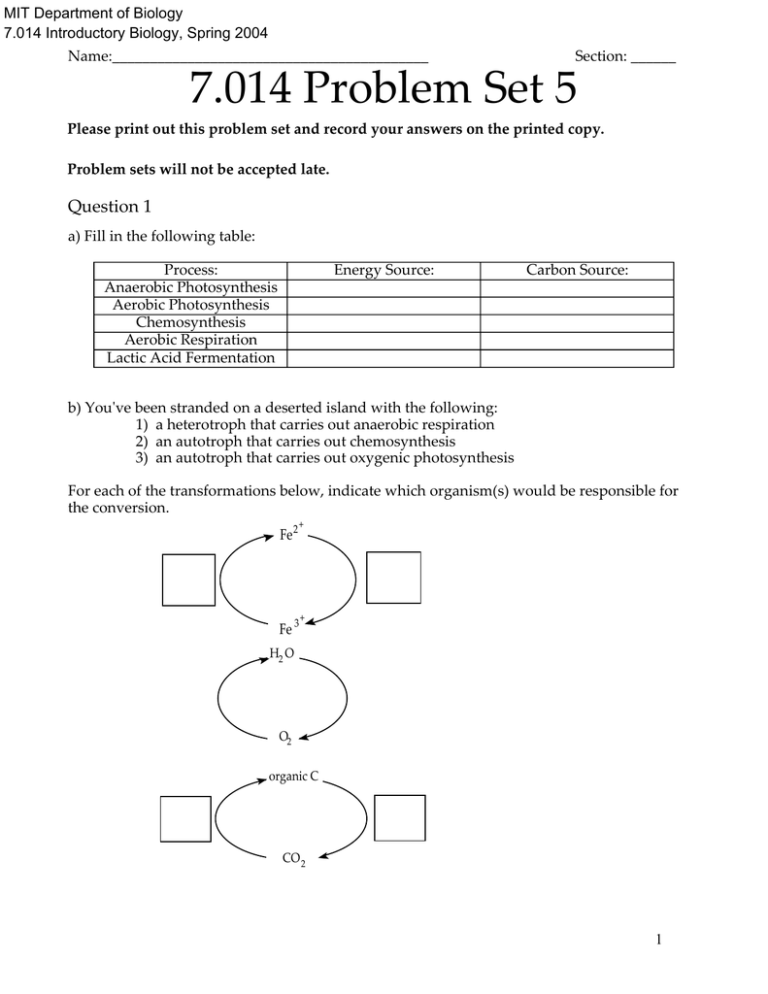
MIT Department of Biology 7.014 Introductory Biology, Spring 2004 Name:__________________________________________ Section: ______ 7.014 Problem Set 5 Please print out this problem set and record your answers on the printed copy. Problem sets will not be accepted late. Question 1 a) Fill in the following table: Process: Anaerobic Photosynthesis Aerobic Photosynthesis Chemosynthesis Aerobic Respiration Lactic Acid Fermentation Energy Source: Carbon Source: b) You've been stranded on a deserted island with the following: 1) a heterotroph that carries out anaerobic respiration 2) an autotroph that carries out chemosynthesis 3) an autotroph that carries out oxygenic photosynthesis For each of the transformations below, indicate which organism(s) would be responsible for the conversion. Fe 2 Fe + 3+ H2 O2+ O2 organic C CO 2 1 Name:__________________________________________ Section: ______ Question 1, continued c) Fill in the blanks on the following graph and indicate which type of metabolism this organism is using. CO 2 NADH + H+ e– O2 e– glucose NAD + H 2O H+ gradient ADP + P i ATP Metabolism?______________ d) Consider the metabolism diagrammed below: 1 SO42 - e- O2 3 2 H2S H2 O 4 H+ gradient ADP + P i ATP 2- SO4 H2S e- NADP + NADPH i) This type of metabolism is an example of __________________. It is most commonly carried out by ________________ organisms. These organisms are _________trophs. ii) What is the energy stored in the ATP and the NADPH produced above used for? 2 Name:__________________________________________ Section: ______ Question 2 Your ongoing interest in bioluminescent organisms has lead you to study the Hawaiian squid, Euprymna scolopes. Most nocturnal creatures cast shadows under the bright Hawaiian moonlight, and are easy prey to predatory fish. This type of squid can shine light downwards to match the moonlight and avoid casting a shadow thereby decreasing predation. To provide squid for your studies, you maintain a large, self-supporting squid tank. The food web of the tank is shown below. small fish squid phytoplankton detritivores When your tank is at steady state, you can harvest 10 kg of squid carbon/week and all the other biomasses (phytoplankton, fish, squid, and detritivores) remain constant. Given the following values: • NPP of phytoplankton = 2.0 kilograms of organic carbon per gram of phytoplankton per day • phytoplankton production efficiency = 60% • fish exploitation efficiency = 50% • fish assimilation efficiency = 20% • fish net production efficiency = 5% • squid exploitation efficiency = 50% • squid assimilation efficiency = 80% • squid net production efficiency = 40% a) What NPP (in kilograms of carbon) is required to support a harvest of 10 kg of squid carbon per week at steady state? Show your work. 3 Name:__________________________________________ Section: ______ Question 2, continued b) Month after month, your squid harvest is 10 kg/week and all the biomasses remain constant. One month, you find that you can only harvest 5 kg of squid carbon/week and maintain steady state. You suspect that something has contaminated your tank and reduced your yield. You propose two models to account for the reduction in yield. To test these models, you measure the respiration rate of the detritivores in the tank. You find that detritivore respiration has increased by 5 kg of carbon per week. Model 1: Phytoplankton photosynthesis is inhibited so that they now only produce 1.0 kilogram of organic carbon per gram of phytoplankton per day, but at this new steady state, all other efficiencies remain constant. i) Is this model consistent with your measurement? Explain. Model 2: 5 kg of fish per week are dying with all other efficiencies remaining constant. ii) Is this model consistent with your measurement? Explain. 4 Name:__________________________________________ Section: ______ Question 3 a) You have just won the lottery and you and 10 friends decide to sail around the world in your new yacht. Unfortunately, due to stormy seas in the Pacific, you find yourselves shipwrecked on a remote island near Micronesia. On the island there are trees and edible plants, plant-eating boars, and lions. Sun B Plants A F C Herbivores G D J I E H Carnivores L K Detritivores M i) In one sentence, describe what each of the following flows represents. A: C: D: F: b) In terms of the flows given on the energy flow diagram: i) What is the production efficiency of the carnivores? ii) What is the exploitation efficiency of the herbivores? iii) If the NPP is 1 x 106 grams C, what is the respiration of herbivores if the EEH = 0.5, AEH = 0.2, PEH = 0.6? iv) Using the letters given on the above diagram, write the equation for Net Community Production (NCP). The NCP is the organic carbon produced through photosynthesis and not lost through respiration. (M is the respiration of the detritivores.) 5 Name:__________________________________________ Section: ______ Question 3, continued c) As vegetarians, your introduction into the ecosystem changes the energy flow of the system. In the table below indicate if the flow would increase, decrease, or stay the same as a consequence of your introduction into the ecosystem. Assume the gross primary production (GPP) does not change. There may be more than one correct answer, so choose only one and explain your answer. increase or decrease explain C D F I d) Some time after your introduction to the island, the ecosystem reaches a new steady state. Unfortunately, a tribe of cannibals visits the island, captures you, your friends, and all the plant-eating boars and returns to their homeland. (You are later rescued and return to MIT to finish your studies). Once the terrestrial ecosystem reaches a new equilibrium, how has the number of trophic levels changed? Explain your answer. 6 Name:__________________________________________ Section: ______ Question 4 Biogeochemical cycles are necessary for life to exist. Three of the most important cycles are the Nitrogen, Carbon, and Hydrological Cycles. a) After reading the article, “Human domination of Earth’s Ecosystems,” describe the impact that humans have had on each of these cycles. b) Explain why the Biosphere2 project suffered from a critical decrease in O2 levels. Sketch the carbon cycle as it would have been in the Biosphere2 dome. c) The productivity (the g C m-2 year-1) of an acre of farmland in California looks to be much greater than the productivity of that same land prior to agricultural advances. Give three reasons why this increase in productivity is overestimated. 7 Name:__________________________________________ Section: ______ Question 4, continued d) When considering how well life will thrive in an aquatic environment, two major factors are usually considered: the ability of light to penetrate to an appropriate depth and the availability of various nutrients in the water. Many organisms thrive near the surface of the water because of the accessibility to sunlight, but eventually the nutrients in the surface water are insufficient to sustain life. Much of the dead biomass floats to the bottom where it decomposes and creates a nutrient-rich environment. However, light cannot penetrate to this depth and so very little can grow. Moreover, a steep temperature gradient called a thermocline prevents mixing of the upper and lower waters. Explain the following phenomena in term of limiting factors and thermoclines: i) Plankton thrive in the wake of a hurricane. ii) Algae bloom in lakes in the spring. iii) An increase the primary productivity along the coast e) In New England the soil has a higher percent of nitrogen and phosphorus than does the living biomass. In a tropical forest, the reverse is true. In an experiment, you fertilize soil from the rain forest with phosphorus and nitrogen containing compounds and find an increase in plant growth. i) If you repeated the experiment in a New England forest, would you expect the same result? Explain your answer. ii) What two major factors influence the density of biomass in an environment? 8

